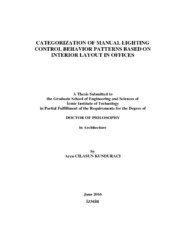Please use this identifier to cite or link to this item:
https://hdl.handle.net/11147/4834Full metadata record
| DC Field | Value | Language |
|---|---|---|
| dc.contributor.advisor | Kazanasmaz, Zehra Tuğçe | - |
| dc.contributor.author | Cılasun Kunduracı, Arzu | - |
| dc.date.accessioned | 2017-02-14T07:40:17Z | - |
| dc.date.available | 2017-02-14T07:40:17Z | - |
| dc.date.issued | 2016-06 | - |
| dc.identifier.citation | Cılasun Kunduracı, A. (2016). Categorization of manual lighting control behavior patterns based on interior layout in offices. Unpublished doctoral dissertation, İzmir Institute of Technology, İzmir, Turkey | en_US |
| dc.identifier.uri | http://hdl.handle.net/11147/4834 | - |
| dc.description | Thesis (Doctoral)--İzmir Institute of Technology, Architecture, İzmir, 2016 | en_US |
| dc.description | Full text release delayed at author's request until 2018.07.12 | en_US |
| dc.description | Includes bibliographical references (leaves: 121-129) | en_US |
| dc.description | Text in English; Abstract: Turkish and English | en_US |
| dc.description | viii, 179 leaves | en_US |
| dc.description.abstract | To reduce energy consumption due to lighting, variety of methods such as energy efficient products, daylight and lighting control systems, simulation softwares are being used. However, these methods may fall short of their potential if the end user, occupants, are not taken into consideration. Energy consumption due to lighting can be reduced further by understanding building occupants’ needs and behaviors. In this study, to understand user behavior for lighting, manual lighting control of occupants were examined. This examination compromises physical, temporal and architectural factors which affect manual lighting control behavior. Especially the focus was on interior layout to observe the relation between the architectural parameters and manual lighting control behavior. The goal of the research and experiments of this dissertation was to obtain realistic manual lighting control data in offices. First of all, various parameters including physical, visual, occupancy and architectural were observed and statistically analyzed by the conducted questionnaire, to find the most triggering/inhibiting factors for manual lighting control. Secondly three private offices were equipped to monitor the change in manual lighting control behavior with regards to occupancy, daylight penetration and interior layout. Results used to generate from the fuzzy model which offers more detailed classifications on manual lighting control probabilities. Gathered results showed that interior layout has a significant contribution to manual lighting control. As a result, if architects/lighting designers/researchers utilize the provided classifications of the tested parameters on the future studies, they can reduce energy consumption while increasing user satisfaction. | en_US |
| dc.description.abstract | Aydınlatma için harcanan enerji tüketimini azaltmak için, enerji verimli ürünler, günışığı-yapay aydınlatma kontrol sistemleri, simülasyon programları gibi pek çok yöntem kullanılmaktadır. Fakat yapıların kullanıcıları dikkate alınmadığı durumda bu yöntemler yetersiz kalabilir. Yapılarda aydınlatma amacıyla harcanan enerji tüketimi, yapı kullanıcılarının ihtiyaçlarını ve davranışlarını anlama ile de azaltılabilir. Bu çalışmada, aydınlatmada kullanıcı davranışı, manuel aydınlatma kontrolü açısından incelenmiştir. Bu incelemede, fiziksel, zamansal ve mimari faktörlerin manuel aydınlatma kontrolüne etkisi irdelenmiştir. Özellikle mimari parametreleri ve iç mekan biçimlenişinin manuel aydınlatma kontrolü ile olan ilişkisi gözlenmiştir. Bu çalışma ve deneylerin amacı ofislerdeki manuel aydınlatma kontrolüne ilişkin gerçekçi veriye ulaşmaktı. Bunun için öncelikle fiziksel, görsel, varlık ve mimari değişkenlerin anket ile incelenmesi ve istatistik olarak analizi gerçekleştirilerek, manuel aydınlatma kontrolü tetikleyen/engelleyen faktörler belirlenmiştir. Sonrasında üç tek kişilik ofiste yerleştirilen sensörler aracılığı ile varlık, günışığı ve iç mekandaki değişikliklerin manuel aydınlatma kontrolündeki değişimler incelenmiştir. Elde edilen sonuçlar ile manuel aydınlatma kontrol olasılıklarını sınıflandırma amacı ile bulanık model oluşturmada kullanılmıştır. Elde edilen sonuçlar, iç mekanın manuel aydınlatmayı kontrol etmede oldukça etkin rol oynadığını göstermiştir. Sonuç olarak eğer mimarlar/aydınlatma tasarımcıları/ araştırmacılar test edilen parametrelerden elde edilen sınıflandırmaları kullanırlarsa, aydınlatma için harcanan enerjiyi düşürürken, kullanıcı memnuniyetini arttırmayı sağlayabilirler. | en_US |
| dc.language.iso | en | en_US |
| dc.publisher | İzmir Institute of Technology | en_US |
| dc.rights | info:eu-repo/semantics/openAccess | en_US |
| dc.subject | Daylighting | en_US |
| dc.subject | Interior space | en_US |
| dc.subject | Artificial lighting | en_US |
| dc.subject | Architectural lighting | en_US |
| dc.subject | Manual lighting control | en_US |
| dc.title | Categorization of Manual Lighting Control Behavior Patterns Based on Interior Layout in Offices | en_US |
| dc.title.alternative | Ofislerde Manuel Aydınlatma Kontrolü Davranış Biçimlerinin İç Mekan Düzenine Dayanılarak Sınıflandırılması | en_US |
| dc.type | Doctoral Thesis | en_US |
| dc.institutionauthor | Cılasun Kunduracı, Arzu | - |
| dc.department | Thesis (Doctoral)--İzmir Institute of Technology, Architecture | en_US |
| dc.request.email | acilasun@hotmail.com | - |
| dc.request.fullname | Arzu Cılasun Kunduracı | - |
| dc.relation.publicationcategory | Tez | en_US |
| dc.identifier.wosquality | N/A | - |
| dc.identifier.scopusquality | N/A | - |
| item.openairecristype | http://purl.org/coar/resource_type/c_18cf | - |
| item.languageiso639-1 | en | - |
| item.openairetype | Doctoral Thesis | - |
| item.grantfulltext | open | - |
| item.fulltext | With Fulltext | - |
| item.cerifentitytype | Publications | - |
| Appears in Collections: | Phd Degree / Doktora | |
Files in This Item:
| File | Description | Size | Format | |
|---|---|---|---|---|
| T001482.pdf | DoctoralThesis | 9.62 MB | Adobe PDF |  View/Open |
CORE Recommender
Page view(s)
234
checked on Mar 31, 2025
Download(s)
236
checked on Mar 31, 2025
Google ScholarTM
Check
Items in GCRIS Repository are protected by copyright, with all rights reserved, unless otherwise indicated.